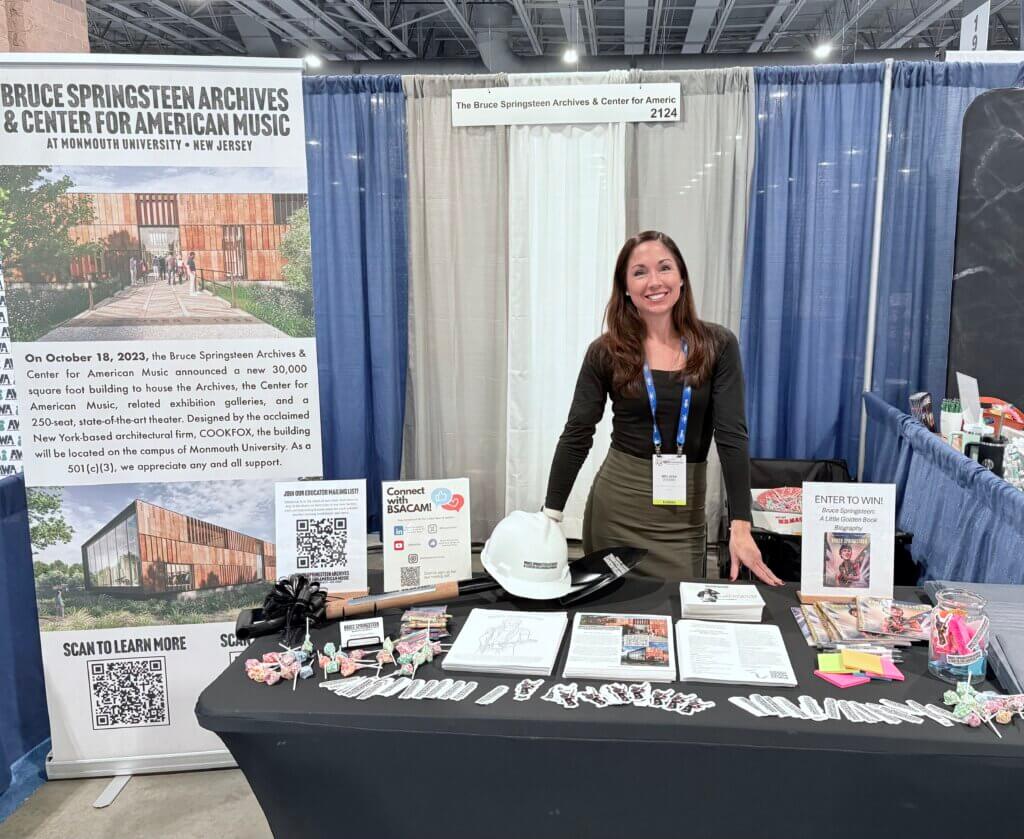Last week, I attended the 2025 New Jersey Education Association (NJEA) Convention in Atlantic City—a massive annual gathering that brings together thousands of teachers, administrators, librarians, counselors, and education advocates from across the Garden State. The convention buzzes with energy and ideas, offering professional development sessions, hands-on workshops, and a vibrant exhibition floor showcasing organizations that support the education community.
There was even some ax throwing going on—I guess that’s one way to manage stress!
This was my second year attending on behalf of the Bruce Springsteen Archives and Center for American Music (BSACAM), sharing information about our work with one of New Jersey’s greatest resources—its teachers. While our collections, exhibitions, and programs have long drawn Bruce fans from around the world, the NJEA Convention lets us connect with another vital audience: the educators and students of our home state.
Why We Were There
At the BSACAM, education is central to our mission. Yes, we safeguard Bruce Springsteen’s personal archives—his handwritten lyrics, photographs, setlists, correspondence, and more—but we also use music from across centuries and genres to tell broader stories about America. Those stories resonate not just with Bruce fans, but with anyone who cares about music, history, culture, and the power of art to inspire learning.
That’s why we were excited to meet the teachers shaping young minds across New Jersey and to explore how the BSACAM can serve as a resource for education at all levels—especially as we prepare to open our new 30,000-square-foot home in June 2026. We want teachers to know we’ll be more than a destination for researchers or superfans—we’ll be a living, ever-changing educational hub where music becomes a lens for understanding American life.
Music as a Tool for Teaching
Throughout the convention, I spoke with dozens of educators about how they bring music into their classrooms already. Some use Springsteen’s lyrics to explore themes like social justice, working-class identity, or the American Dream. Others connect rock and folk traditions to larger narratives about civil rights, immigration, or protest movements.
One high school history teacher told me his students studied “Born in the U.S.A.” during a unit on the Vietnam War and postwar America.
“Most of them had never really listened to the lyrics before,” he said. “But once they did a close read, they got it—it opened up conversations about patriotism, trauma, and what it means to love your country.”
That particular story resonated deeply with me, as I’m currently writing a book titled Born in the U.S.A.: Bruce Springsteen, Bart Haynes, Walter Cichon—and the Vietnam War. It’s exactly the kind of engagement we hope to foster through our exhibits, field trips, and educational programming.
Expanding Our Educational Mission
The BSACAM has already made important strides in k-12 education. Together with Monmouth University’s Department of History and Anthropology, we host a History Day competition that brings several hundred students, grades 6–12, to campus each winter to present their research projects.
We also host teacher training sessions that show how music can bring history to life and how primary sources—from handwritten song drafts to oral histories—can teach critical thinking, creativity, and empathy.
Still, the NJEA Convention reminded me how much room there is to grow. I met so many educators who had never heard of us, and I want all of them—”from the coastline to the city”—to know we’re here to support their teaching already; and preparing to welcome them and their students for curriculum-aligned field trips once our new building opens in late spring 2026.
Serving Fans—and the Future
As Bruce himself has often said, music is about connection—and that connection extends far beyond any one generation.
By reaching out to educators and students, we’re ensuring that the stories we preserve continue to inspire new audiences. The teenager discovering Darkness on the Edge of Town for the first time in a history class might become tomorrow’s archivist, songwriter, or activist. The teacher who brings “The River” into a discussion of economic hardship may spark a lifelong appreciation for storytelling as social commentary.
A Shared Sense of Purpose
As a longtime educator myself—I’ve been teaching history at Monmouth University for 18 years—I felt a real sense of connection and opportunity at the NJEA Convention. Because whether you’re standing in a classroom or on a concert stage, the goal is really the same: to educate, to inspire, and to help people see themselves and their world a little more clearly.
After all, sometimes the best lessons really do come from a three-minute record.
Are you an educator in NJ? We value your input on how we can best serve you. Click here to take our education survey!

Melissa Ziobro
Director of Curatorial Affairs
Bruce Springsteen Archives & Center for American Music
Monmouth University
November 13, 2025
